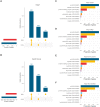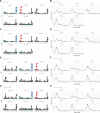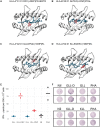Characterization of the Class I MHC Peptidome Resulting From DNCB Exposure of HaCaT Cells
- PMID: 33372950
- PMCID: PMC7916740
- DOI: 10.1093/toxsci/kfaa184
Characterization of the Class I MHC Peptidome Resulting From DNCB Exposure of HaCaT Cells
Abstract
Skin sensitization following the covalent modification of proteins by low molecular weight chemicals (haptenation) is mediated by cytotoxic T lymphocyte (CTL) recognition of human leukocyte antigen (HLA) molecules presented on the surface of almost all nucleated cells. There exist 3 nonmutually exclusive hypotheses for how haptens mediate CTL recognition: direct stimulation by haptenated peptides, hapten modification of HLA leading to an altered HLA-peptide repertoire, or a hapten altered proteome leading to an altered HLA-peptide repertoire. To shed light on the mechanism underpinning skin sensitization, we set out to utilize proteomic analysis of keratinocyte presented antigens following exposure to 2,4-dinitrochlorobenzene (DNCB). We show that the following DNCB exposure, cultured keratinocytes present cysteine haptenated (dinitrophenylated) peptides in multiple HLA molecules. In addition, we find that one of the DNCB modified peptides derives from the active site of cytosolic glutathione-S transferase-ω. These results support the current view that a key mechanism of skin sensitization is stimulation of CTLs by haptenated peptides. Data are available via ProteomeXchange with identifier PXD021373.
Keywords: DNCB; HLA; HaCaT; keratinocyte; peptidome.
© The Author(s) 2020. Published by Oxford University Press on behalf of the Society of Toxicology.
Figures




Similar articles
-
Proteomic analysis of the cellular response to a potent sensitiser unveils the dynamics of haptenation in living cells.Toxicology. 2020 Dec 1;445:152603. doi: 10.1016/j.tox.2020.152603. Epub 2020 Sep 28. Toxicology. 2020. PMID: 32991956
-
Ultrastructural studies bearing on the mechanism of UVB-impaired induction of contact hypersensitivity to DNCB in man.Clin Exp Immunol. 1993 Jun;92(3):487-93. doi: 10.1111/j.1365-2249.1993.tb03426.x. Clin Exp Immunol. 1993. PMID: 8513580 Free PMC article.
-
Oral tolerance to haptens: intestinal epithelial cells from 2,4-dinitrochlorobenzene-fed mice inhibit hapten-specific T cell activation in vitro.Eur J Immunol. 1995 May;25(5):1385-90. doi: 10.1002/eji.1830250537. Eur J Immunol. 1995. PMID: 7774642
-
Dendritic cells differently respond to haptens and irritants by their production of cytokines and expression of co-stimulatory molecules.Eur J Immunol. 1997 Nov;27(11):3031-8. doi: 10.1002/eji.1830271141. Eur J Immunol. 1997. PMID: 9394834
-
Drug hapten-specific T-cell activation: Current status and unanswered questions.Proteomics. 2021 Sep;21(17-18):e2000267. doi: 10.1002/pmic.202000267. Epub 2021 Jul 5. Proteomics. 2021. PMID: 33651918 Review.
Cited by
-
Mast Cells in the Skin: Defenders of Integrity or Offenders in Inflammation?Int J Mol Sci. 2021 Apr 27;22(9):4589. doi: 10.3390/ijms22094589. Int J Mol Sci. 2021. PMID: 33925601 Free PMC article. Review.
-
Haptenation of Macrophage Migration Inhibitory Factor: A Potential Biomarker for Contact Hypersensitivity.Front Toxicol. 2022 Apr 6;4:856614. doi: 10.3389/ftox.2022.856614. eCollection 2022. Front Toxicol. 2022. PMID: 35465102 Free PMC article.
-
Identification of neoantigens in oesophageal adenocarcinoma.Immunology. 2023 Mar;168(3):420-431. doi: 10.1111/imm.13578. Epub 2022 Oct 19. Immunology. 2023. PMID: 36111495 Free PMC article.
-
Protein Haptenation and Its Role in Allergy.Chem Res Toxicol. 2024 Jun 17;37(6):850-872. doi: 10.1021/acs.chemrestox.4c00062. Epub 2024 Jun 4. Chem Res Toxicol. 2024. PMID: 38834188 Free PMC article. Review.
-
Immunopeptidomic analysis of influenza A virus infected human tissues identifies internal proteins as a rich source of HLA ligands.PLoS Pathog. 2022 Jan 20;18(1):e1009894. doi: 10.1371/journal.ppat.1009894. eCollection 2022 Jan. PLoS Pathog. 2022. PMID: 35051231 Free PMC article.
References
-
- Aleksic M., Pease C. K., Basketter D. A., Panico M., Morris H. R., Dell A. (2008). Mass spectrometric identification of covalent adducts of the skin allergen 2, 4-dinitro-1-chlorobenzene and model skin proteins. Toxicol. In Vitro 22, 1169–1176. - PubMed
-
- Aleksic M., Thain E., Roger D., Saib O., Davies M., Li J., Aptula A., Zazzeroni R. (2009). Reactivity profiling: Covalent modification of single nucleophile peptides for skin sensitization risk assessment. Toxicol. Sci. 108, 401–411. - PubMed
-
- Banerjee G., Damodaran A., Devi N., Dharmalingam K., Raman G. (2004). Role of keratinocytes in antigen presentation and polarization of human T lymphocytes. Scand. J. Immunol. 59, 385–394. - PubMed
-
- Barnstable C. J., Bodmer W. F., Brown G., Galfre G., Milstein C., Williams A. F., Ziegler A. (1978). Production of monoclonal antibodies to group a erythrocytes, HLA and other human cell surface antigens-new tools for genetic analysis. Cell 14, 9–20. - PubMed
Publication types
MeSH terms
Substances
LinkOut - more resources
Full Text Sources
Molecular Biology Databases
Research Materials

